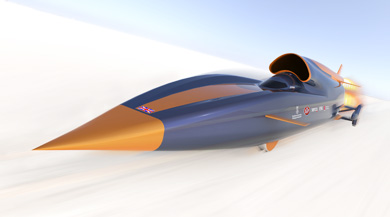
While most engineers focus on improving the fuel efficiency of conventional cars and trucks, a team of Britons is working to produce a vehicle that not only will shatter the current land-speed record, but travel faster than any low-altitude jet aircraft, as well.
The program, headed by adventurer and entrepreneur Richard Noble, is called the Bloodhound project and aims to stimulate future generations into careers in science, engineering and mathematics.
Recently unveiled in model form at London’s Science Museum, the Bloodhound Super Sonic Car will be piloted by Royal Air Force Wing Commander Andy Green, who 11 years ago set the current LSR of 763 mph (1,228 km/h) in Noble’s ThrustSSC streamliner on a dry lakebed in Nevada.
When completed sometime before 2011, Noble says the BloodhoundSSC will rocket across Utah’s Bonneville Salt Flats faster than a bullet fired from a handgun, eventually establishing a new LSR of 1,000 mph (1,609 km/h).
The current record for low-altitude flight is 994 mph (1,600 km/h).
Power for the 42-ft. (12.8-m) long, 9-ft. (2.7-m) high and 14,158-lb. (6,422-kg) Bloodhound SSC primarily will come from a Typhoon Eurojet EJ200 jet engine generating 20,000 lbs. (9,072 kg) of thrust, Noble says. However, a Falcon hybrid rocket, with an additional 27,000 lbs. (12,247 kg) of thrust, will help the vehicle reach its maximum velocity.

In addition to the power package, engineers have determined the BloodhoundSSC’s wheels are crucial to its success.
To hit the target speed of Mach 1.4, the wheels must withstand rotations of 10,500 rpm and resist damage from stones or other obstacles they run over. Also, the wheels must be lightweight to minimize steering and suspension forces, yet robust enough to handle extremely high downforce loads and stresses.
To fuel the rocket engine, the team will use a V-12 racecar engine to pump 1 ton (0.9 t) of high-test hydrogen peroxide fuel into the vehicle before ignition. The pump must operate at 12,000 rpm to deliver the HTP in less than 20 seconds.
“To pump such a large amount of volatile liquid through a small tank at such high speeds is an incredibly dangerous business,” says Greg Horler, CEO of Instrumental Ltd. “If it doesn’t work perfectly, it could explode at any time.”
An integrated electronics system will engage the gearbox and clutch of the V-12, control the throttle position and measure data from the pump.
Estimated to cost £10.5 million ($16.1 million), the BloodhoundSSC is under development at the University of the West of England in Bristol, with scientists at the National Physical Laboratory and Britain’s Atomic Weapons Establishment also collaborating on the effort.




